
[MVP][WIP] `less` like pager (#6984)
Run it as `explore`.
#### example
```nu
ls | explore
```
Configuration points in `config.nu` file.
```
# A 'explore' utility config
explore_config: {
highlight: { bg: 'yellow', fg: 'black' }
status_bar: { bg: '#C4C9C6', fg: '#1D1F21' }
command_bar: { fg: '#C4C9C6' }
split_line: '#404040'
cursor: true
# selected_column: 'blue'
# selected_row: { fg: 'yellow', bg: '#C1C2A3' }
# selected_cell: { fg: 'white', bg: '#777777' }
# line_shift: false,
# line_index: false,
# line_head_top: false,
# line_head_bottom: false,
}
```
You can start without a pipeline and type `explore` and it'll give you a
few tips.
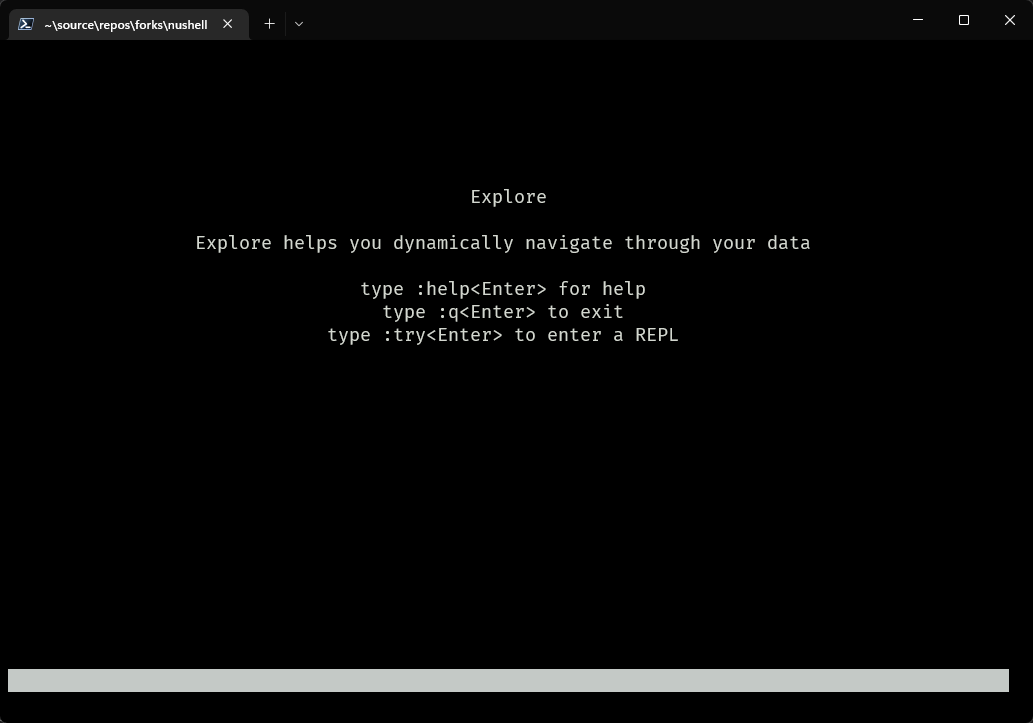
If you type `:help` you an see the help screen with some information on
what tui keybindings are available.
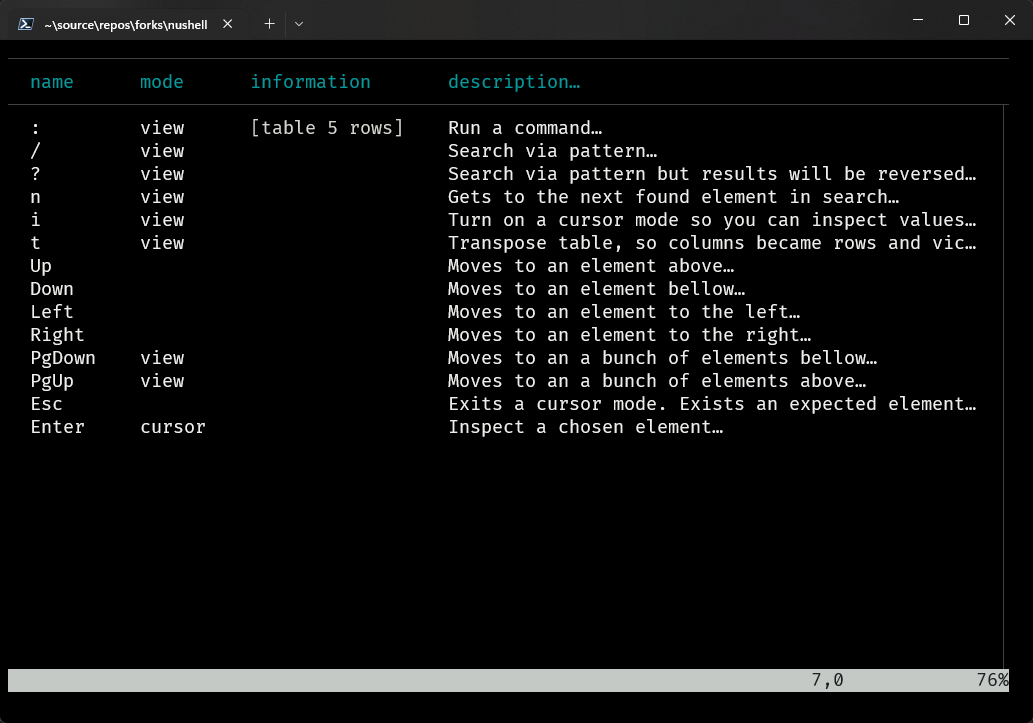
From the `:help` screen you can now hit `i` and that puts you in
`cursor` aka `inspection` mode and you can move the cursor left right up
down and it you put it on an area such as `[table 5 rows]` and hit the
enter key, you'll see something like this, which shows all the `:`
commands. If you hit `esc` it will take you to the previous screen.
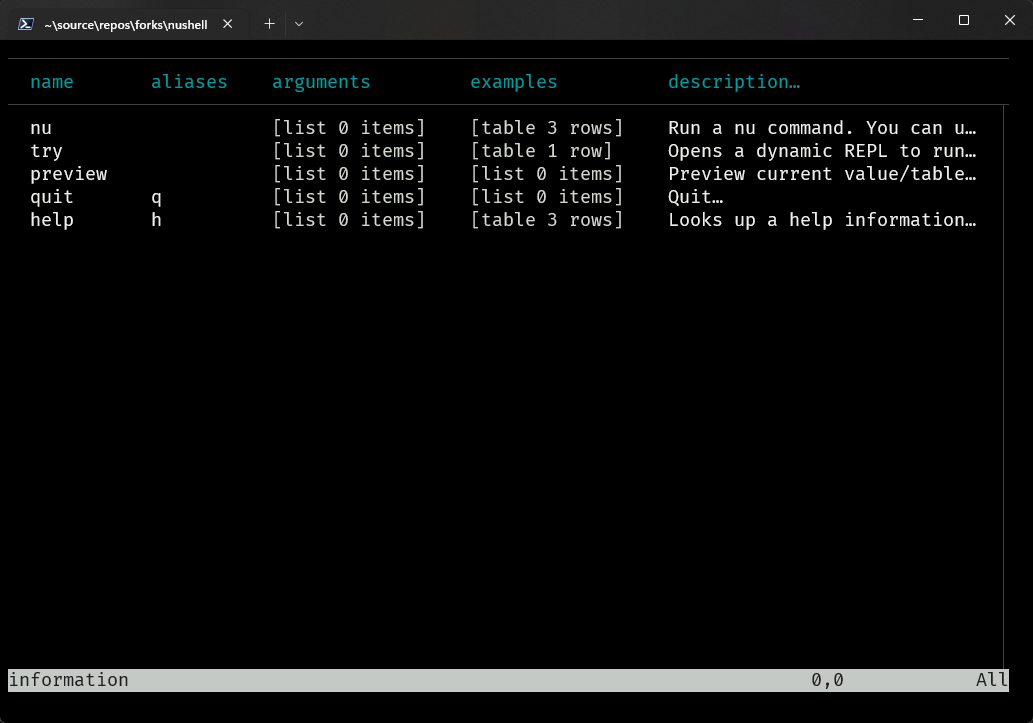
If you then type `:try` you'll get this type of window where you can
type in the top portion and see results in the bottom.
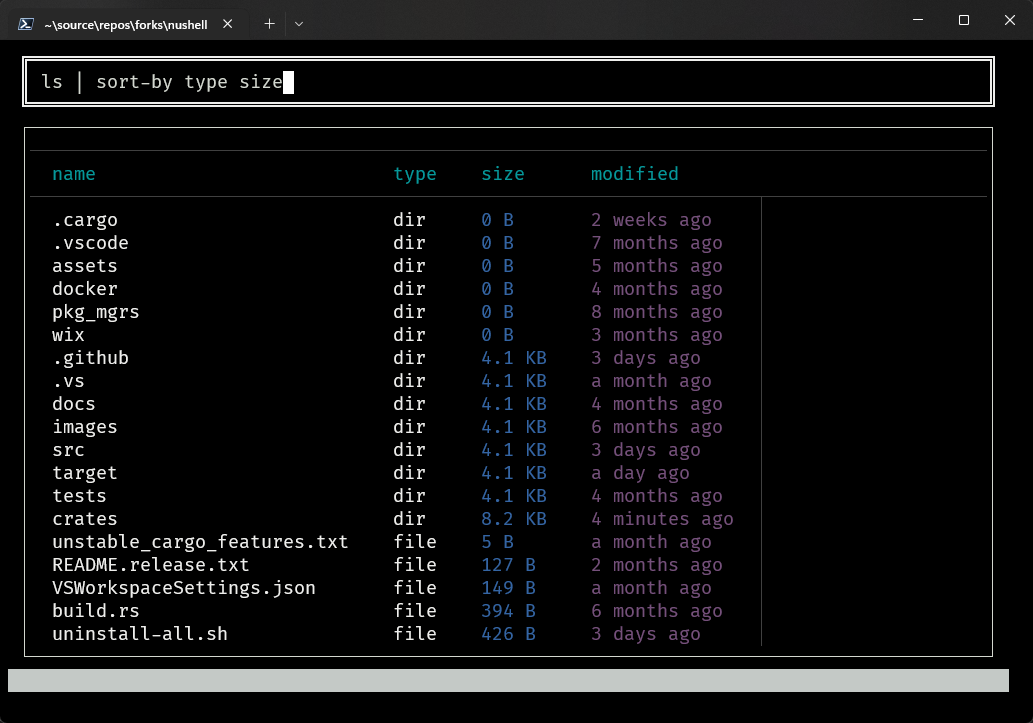
The `:nu` command is interesting because you can type pipelines like
`:nu ls | sort-by type size` or another pipeline of your choosing such
as `:nu sys` and that will show the table that looks like this, which
we're calling "table mode".
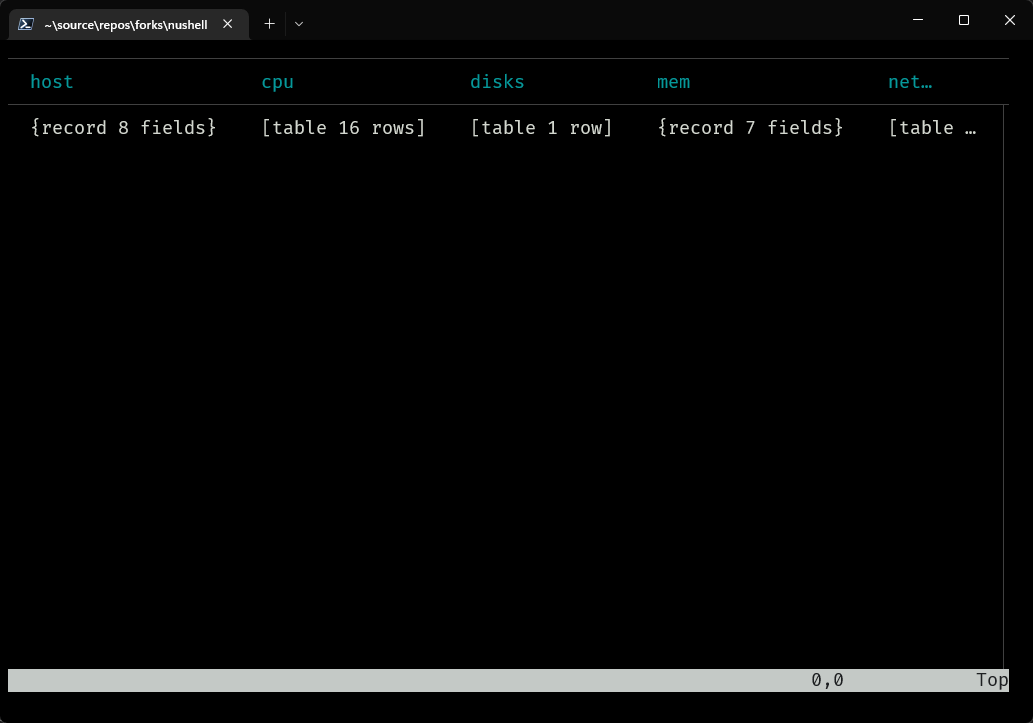
If you hit the `t` key it will now transpose the view to look like this.
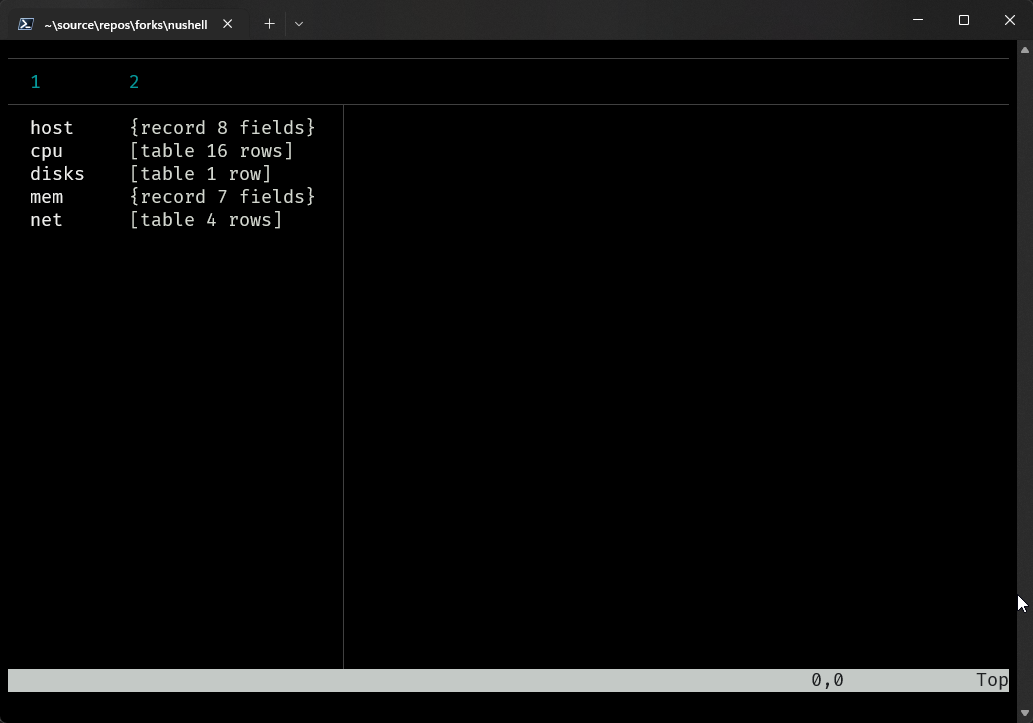
In table mode or transposed table mode you can use the `i` key to
inspect any collapsed field like `{record 8 fields}`, `[table 16 rows]`,
`[list x]`, etc.
One of the original benefits was that when you're in a view that has a
lot of columns, `explore` gives you the ability to scroll left, right,
up, and down.
`explore` is also smart enough to know when you're in table mode versus
preview mode. If you do `open Cargo.toml | explore` you get this.
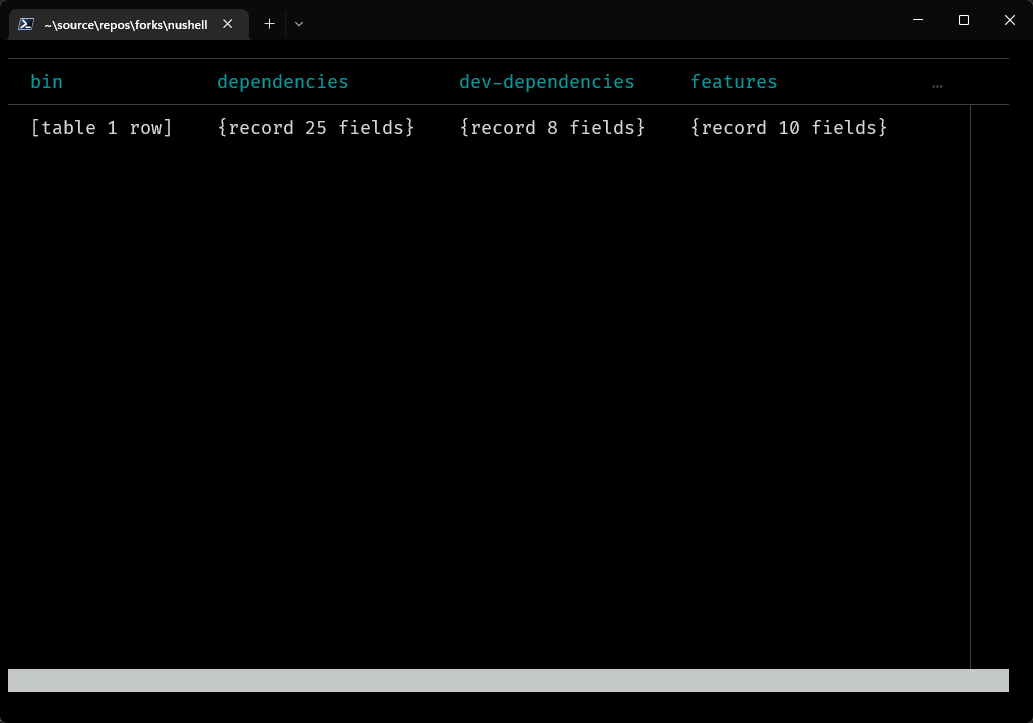
If you type `open --raw Cargo.toml | explore` you get this where you can
scroll left, right, up, down. This is called preview mode.
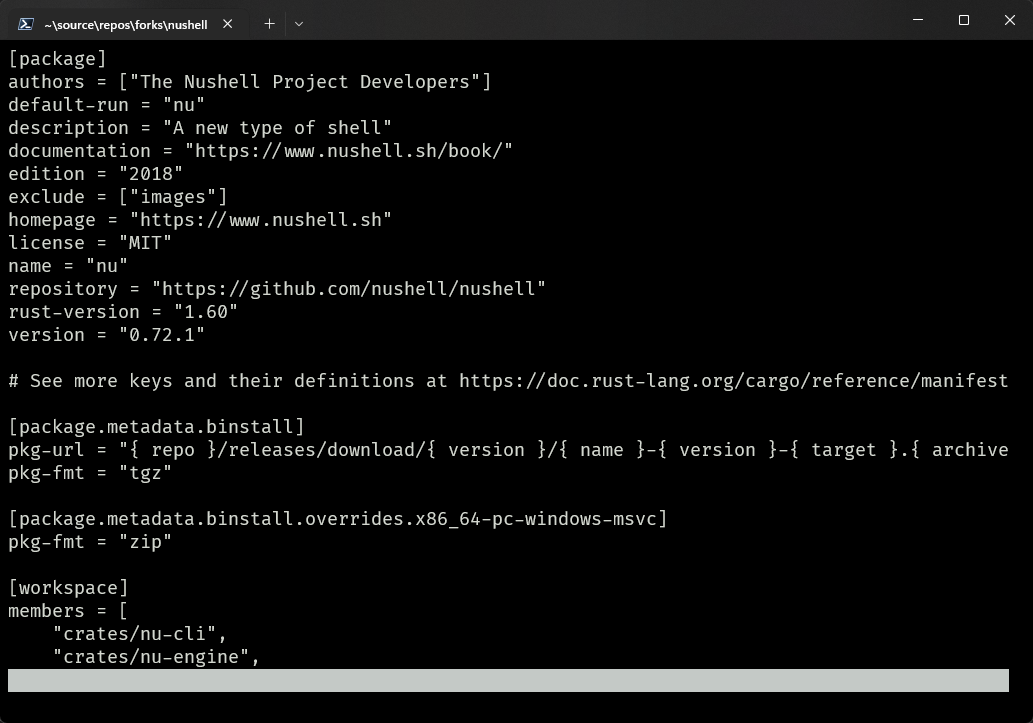
When you're in table mode, you can also type `:preview`. So, with `open
--raw Cargo.toml | explore`, if you type `:preview`, it will look like
this.
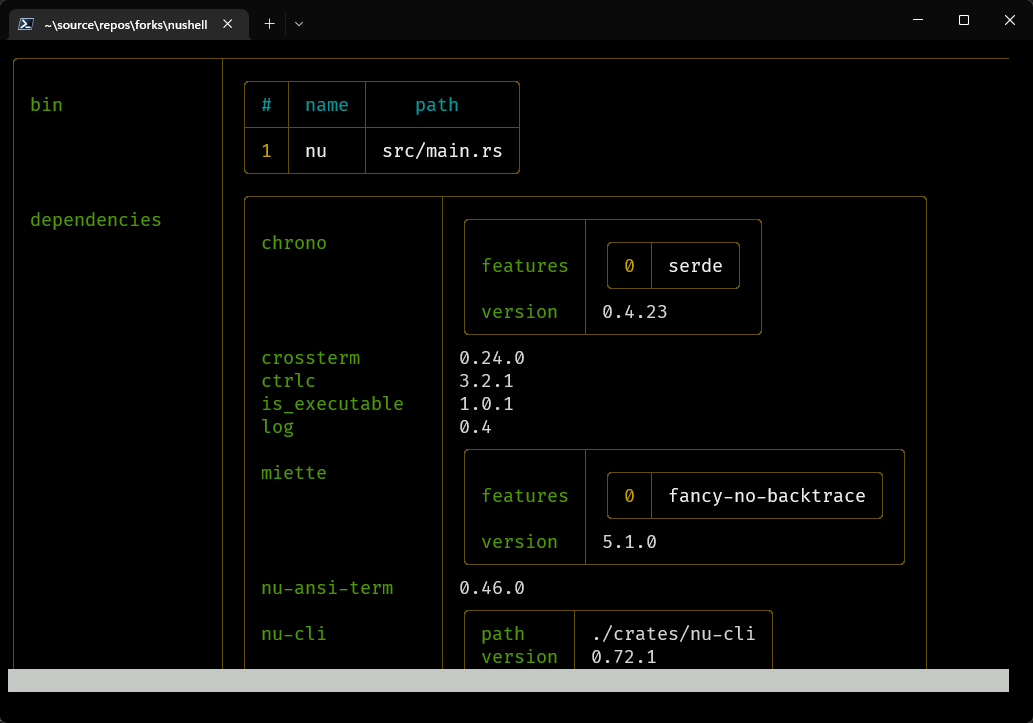
Signed-off-by: Maxim Zhiburt <zhiburt@gmail.com>
Co-authored-by: Darren Schroeder <343840+fdncred@users.noreply.github.com>
2022-12-01 16:32:10 +01:00
|
|
|
mod commands;
|
|
|
|
|
mod nu_common;
|
|
|
|
|
mod pager;
|
2022-12-16 16:47:07 +01:00
|
|
|
mod registry;
|

[MVP][WIP] `less` like pager (#6984)
Run it as `explore`.
#### example
```nu
ls | explore
```
Configuration points in `config.nu` file.
```
# A 'explore' utility config
explore_config: {
highlight: { bg: 'yellow', fg: 'black' }
status_bar: { bg: '#C4C9C6', fg: '#1D1F21' }
command_bar: { fg: '#C4C9C6' }
split_line: '#404040'
cursor: true
# selected_column: 'blue'
# selected_row: { fg: 'yellow', bg: '#C1C2A3' }
# selected_cell: { fg: 'white', bg: '#777777' }
# line_shift: false,
# line_index: false,
# line_head_top: false,
# line_head_bottom: false,
}
```
You can start without a pipeline and type `explore` and it'll give you a
few tips.

If you type `:help` you an see the help screen with some information on
what tui keybindings are available.

From the `:help` screen you can now hit `i` and that puts you in
`cursor` aka `inspection` mode and you can move the cursor left right up
down and it you put it on an area such as `[table 5 rows]` and hit the
enter key, you'll see something like this, which shows all the `:`
commands. If you hit `esc` it will take you to the previous screen.

If you then type `:try` you'll get this type of window where you can
type in the top portion and see results in the bottom.

The `:nu` command is interesting because you can type pipelines like
`:nu ls | sort-by type size` or another pipeline of your choosing such
as `:nu sys` and that will show the table that looks like this, which
we're calling "table mode".

If you hit the `t` key it will now transpose the view to look like this.

In table mode or transposed table mode you can use the `i` key to
inspect any collapsed field like `{record 8 fields}`, `[table 16 rows]`,
`[list x]`, etc.
One of the original benefits was that when you're in a view that has a
lot of columns, `explore` gives you the ability to scroll left, right,
up, and down.
`explore` is also smart enough to know when you're in table mode versus
preview mode. If you do `open Cargo.toml | explore` you get this.

If you type `open --raw Cargo.toml | explore` you get this where you can
scroll left, right, up, down. This is called preview mode.

When you're in table mode, you can also type `:preview`. So, with `open
--raw Cargo.toml | explore`, if you type `:preview`, it will look like
this.

Signed-off-by: Maxim Zhiburt <zhiburt@gmail.com>
Co-authored-by: Darren Schroeder <343840+fdncred@users.noreply.github.com>
2022-12-01 16:32:10 +01:00
|
|
|
mod views;
|
|
|
|
|
|
|
|
|
|
use std::io;
|
|
|
|
|
|
2022-12-16 16:47:07 +01:00
|
|
|
use commands::{
|
|
|
|
|
config::ConfigCmd, default_color_list, ConfigOption, ConfigShowCmd, ExpandCmd, HelpCmd,
|
|
|
|
|
HelpManual, NuCmd, QuitCmd, TableCmd, TryCmd, TweakCmd,
|
|
|
|
|
};
|
2022-12-01 19:14:56 +01:00
|
|
|
use nu_common::{collect_pipeline, has_simple_value, CtrlC};
|

[MVP][WIP] `less` like pager (#6984)
Run it as `explore`.
#### example
```nu
ls | explore
```
Configuration points in `config.nu` file.
```
# A 'explore' utility config
explore_config: {
highlight: { bg: 'yellow', fg: 'black' }
status_bar: { bg: '#C4C9C6', fg: '#1D1F21' }
command_bar: { fg: '#C4C9C6' }
split_line: '#404040'
cursor: true
# selected_column: 'blue'
# selected_row: { fg: 'yellow', bg: '#C1C2A3' }
# selected_cell: { fg: 'white', bg: '#777777' }
# line_shift: false,
# line_index: false,
# line_head_top: false,
# line_head_bottom: false,
}
```
You can start without a pipeline and type `explore` and it'll give you a
few tips.

If you type `:help` you an see the help screen with some information on
what tui keybindings are available.

From the `:help` screen you can now hit `i` and that puts you in
`cursor` aka `inspection` mode and you can move the cursor left right up
down and it you put it on an area such as `[table 5 rows]` and hit the
enter key, you'll see something like this, which shows all the `:`
commands. If you hit `esc` it will take you to the previous screen.

If you then type `:try` you'll get this type of window where you can
type in the top portion and see results in the bottom.

The `:nu` command is interesting because you can type pipelines like
`:nu ls | sort-by type size` or another pipeline of your choosing such
as `:nu sys` and that will show the table that looks like this, which
we're calling "table mode".

If you hit the `t` key it will now transpose the view to look like this.

In table mode or transposed table mode you can use the `i` key to
inspect any collapsed field like `{record 8 fields}`, `[table 16 rows]`,
`[list x]`, etc.
One of the original benefits was that when you're in a view that has a
lot of columns, `explore` gives you the ability to scroll left, right,
up, and down.
`explore` is also smart enough to know when you're in table mode versus
preview mode. If you do `open Cargo.toml | explore` you get this.

If you type `open --raw Cargo.toml | explore` you get this where you can
scroll left, right, up, down. This is called preview mode.

When you're in table mode, you can also type `:preview`. So, with `open
--raw Cargo.toml | explore`, if you type `:preview`, it will look like
this.

Signed-off-by: Maxim Zhiburt <zhiburt@gmail.com>
Co-authored-by: Darren Schroeder <343840+fdncred@users.noreply.github.com>
2022-12-01 16:32:10 +01:00
|
|
|
use nu_protocol::{
|
|
|
|
|
engine::{EngineState, Stack},
|
|
|
|
|
PipelineData, Value,
|
|
|
|
|
};
|
|
|
|
|
use pager::{Page, Pager};
|
2022-12-16 16:47:07 +01:00
|
|
|
use registry::{Command, CommandRegistry};
|

[MVP][WIP] `less` like pager (#6984)
Run it as `explore`.
#### example
```nu
ls | explore
```
Configuration points in `config.nu` file.
```
# A 'explore' utility config
explore_config: {
highlight: { bg: 'yellow', fg: 'black' }
status_bar: { bg: '#C4C9C6', fg: '#1D1F21' }
command_bar: { fg: '#C4C9C6' }
split_line: '#404040'
cursor: true
# selected_column: 'blue'
# selected_row: { fg: 'yellow', bg: '#C1C2A3' }
# selected_cell: { fg: 'white', bg: '#777777' }
# line_shift: false,
# line_index: false,
# line_head_top: false,
# line_head_bottom: false,
}
```
You can start without a pipeline and type `explore` and it'll give you a
few tips.

If you type `:help` you an see the help screen with some information on
what tui keybindings are available.

From the `:help` screen you can now hit `i` and that puts you in
`cursor` aka `inspection` mode and you can move the cursor left right up
down and it you put it on an area such as `[table 5 rows]` and hit the
enter key, you'll see something like this, which shows all the `:`
commands. If you hit `esc` it will take you to the previous screen.

If you then type `:try` you'll get this type of window where you can
type in the top portion and see results in the bottom.

The `:nu` command is interesting because you can type pipelines like
`:nu ls | sort-by type size` or another pipeline of your choosing such
as `:nu sys` and that will show the table that looks like this, which
we're calling "table mode".

If you hit the `t` key it will now transpose the view to look like this.

In table mode or transposed table mode you can use the `i` key to
inspect any collapsed field like `{record 8 fields}`, `[table 16 rows]`,
`[list x]`, etc.
One of the original benefits was that when you're in a view that has a
lot of columns, `explore` gives you the ability to scroll left, right,
up, and down.
`explore` is also smart enough to know when you're in table mode versus
preview mode. If you do `open Cargo.toml | explore` you get this.

If you type `open --raw Cargo.toml | explore` you get this where you can
scroll left, right, up, down. This is called preview mode.

When you're in table mode, you can also type `:preview`. So, with `open
--raw Cargo.toml | explore`, if you type `:preview`, it will look like
this.

Signed-off-by: Maxim Zhiburt <zhiburt@gmail.com>
Co-authored-by: Darren Schroeder <343840+fdncred@users.noreply.github.com>
2022-12-01 16:32:10 +01:00
|
|
|
use terminal_size::{Height, Width};
|
2022-12-16 16:47:07 +01:00
|
|
|
use views::{InformationView, Orientation, Preview, RecordView};
|
|
|
|
|
|
|
|
|
|
pub use pager::{PagerConfig, StyleConfig};
|

[MVP][WIP] `less` like pager (#6984)
Run it as `explore`.
#### example
```nu
ls | explore
```
Configuration points in `config.nu` file.
```
# A 'explore' utility config
explore_config: {
highlight: { bg: 'yellow', fg: 'black' }
status_bar: { bg: '#C4C9C6', fg: '#1D1F21' }
command_bar: { fg: '#C4C9C6' }
split_line: '#404040'
cursor: true
# selected_column: 'blue'
# selected_row: { fg: 'yellow', bg: '#C1C2A3' }
# selected_cell: { fg: 'white', bg: '#777777' }
# line_shift: false,
# line_index: false,
# line_head_top: false,
# line_head_bottom: false,
}
```
You can start without a pipeline and type `explore` and it'll give you a
few tips.

If you type `:help` you an see the help screen with some information on
what tui keybindings are available.

From the `:help` screen you can now hit `i` and that puts you in
`cursor` aka `inspection` mode and you can move the cursor left right up
down and it you put it on an area such as `[table 5 rows]` and hit the
enter key, you'll see something like this, which shows all the `:`
commands. If you hit `esc` it will take you to the previous screen.

If you then type `:try` you'll get this type of window where you can
type in the top portion and see results in the bottom.

The `:nu` command is interesting because you can type pipelines like
`:nu ls | sort-by type size` or another pipeline of your choosing such
as `:nu sys` and that will show the table that looks like this, which
we're calling "table mode".

If you hit the `t` key it will now transpose the view to look like this.

In table mode or transposed table mode you can use the `i` key to
inspect any collapsed field like `{record 8 fields}`, `[table 16 rows]`,
`[list x]`, etc.
One of the original benefits was that when you're in a view that has a
lot of columns, `explore` gives you the ability to scroll left, right,
up, and down.
`explore` is also smart enough to know when you're in table mode versus
preview mode. If you do `open Cargo.toml | explore` you get this.

If you type `open --raw Cargo.toml | explore` you get this where you can
scroll left, right, up, down. This is called preview mode.

When you're in table mode, you can also type `:preview`. So, with `open
--raw Cargo.toml | explore`, if you type `:preview`, it will look like
this.

Signed-off-by: Maxim Zhiburt <zhiburt@gmail.com>
Co-authored-by: Darren Schroeder <343840+fdncred@users.noreply.github.com>
2022-12-01 16:32:10 +01:00
|
|
|
|
2022-12-16 16:47:07 +01:00
|
|
|
pub mod util {
|
2022-12-18 15:43:15 +01:00
|
|
|
pub use super::nu_common::{create_lscolors, create_map, map_into_value};
|
2022-12-16 16:47:07 +01:00
|
|
|
}
|

[MVP][WIP] `less` like pager (#6984)
Run it as `explore`.
#### example
```nu
ls | explore
```
Configuration points in `config.nu` file.
```
# A 'explore' utility config
explore_config: {
highlight: { bg: 'yellow', fg: 'black' }
status_bar: { bg: '#C4C9C6', fg: '#1D1F21' }
command_bar: { fg: '#C4C9C6' }
split_line: '#404040'
cursor: true
# selected_column: 'blue'
# selected_row: { fg: 'yellow', bg: '#C1C2A3' }
# selected_cell: { fg: 'white', bg: '#777777' }
# line_shift: false,
# line_index: false,
# line_head_top: false,
# line_head_bottom: false,
}
```
You can start without a pipeline and type `explore` and it'll give you a
few tips.

If you type `:help` you an see the help screen with some information on
what tui keybindings are available.

From the `:help` screen you can now hit `i` and that puts you in
`cursor` aka `inspection` mode and you can move the cursor left right up
down and it you put it on an area such as `[table 5 rows]` and hit the
enter key, you'll see something like this, which shows all the `:`
commands. If you hit `esc` it will take you to the previous screen.

If you then type `:try` you'll get this type of window where you can
type in the top portion and see results in the bottom.

The `:nu` command is interesting because you can type pipelines like
`:nu ls | sort-by type size` or another pipeline of your choosing such
as `:nu sys` and that will show the table that looks like this, which
we're calling "table mode".

If you hit the `t` key it will now transpose the view to look like this.

In table mode or transposed table mode you can use the `i` key to
inspect any collapsed field like `{record 8 fields}`, `[table 16 rows]`,
`[list x]`, etc.
One of the original benefits was that when you're in a view that has a
lot of columns, `explore` gives you the ability to scroll left, right,
up, and down.
`explore` is also smart enough to know when you're in table mode versus
preview mode. If you do `open Cargo.toml | explore` you get this.

If you type `open --raw Cargo.toml | explore` you get this where you can
scroll left, right, up, down. This is called preview mode.

When you're in table mode, you can also type `:preview`. So, with `open
--raw Cargo.toml | explore`, if you type `:preview`, it will look like
this.

Signed-off-by: Maxim Zhiburt <zhiburt@gmail.com>
Co-authored-by: Darren Schroeder <343840+fdncred@users.noreply.github.com>
2022-12-01 16:32:10 +01:00
|
|
|
|
|
|
|
|
pub fn run_pager(
|
|
|
|
|
engine_state: &EngineState,
|
|
|
|
|
stack: &mut Stack,
|
|
|
|
|
ctrlc: CtrlC,
|
|
|
|
|
input: PipelineData,
|
2022-12-16 16:47:07 +01:00
|
|
|
config: PagerConfig,
|

[MVP][WIP] `less` like pager (#6984)
Run it as `explore`.
#### example
```nu
ls | explore
```
Configuration points in `config.nu` file.
```
# A 'explore' utility config
explore_config: {
highlight: { bg: 'yellow', fg: 'black' }
status_bar: { bg: '#C4C9C6', fg: '#1D1F21' }
command_bar: { fg: '#C4C9C6' }
split_line: '#404040'
cursor: true
# selected_column: 'blue'
# selected_row: { fg: 'yellow', bg: '#C1C2A3' }
# selected_cell: { fg: 'white', bg: '#777777' }
# line_shift: false,
# line_index: false,
# line_head_top: false,
# line_head_bottom: false,
}
```
You can start without a pipeline and type `explore` and it'll give you a
few tips.

If you type `:help` you an see the help screen with some information on
what tui keybindings are available.

From the `:help` screen you can now hit `i` and that puts you in
`cursor` aka `inspection` mode and you can move the cursor left right up
down and it you put it on an area such as `[table 5 rows]` and hit the
enter key, you'll see something like this, which shows all the `:`
commands. If you hit `esc` it will take you to the previous screen.

If you then type `:try` you'll get this type of window where you can
type in the top portion and see results in the bottom.

The `:nu` command is interesting because you can type pipelines like
`:nu ls | sort-by type size` or another pipeline of your choosing such
as `:nu sys` and that will show the table that looks like this, which
we're calling "table mode".

If you hit the `t` key it will now transpose the view to look like this.

In table mode or transposed table mode you can use the `i` key to
inspect any collapsed field like `{record 8 fields}`, `[table 16 rows]`,
`[list x]`, etc.
One of the original benefits was that when you're in a view that has a
lot of columns, `explore` gives you the ability to scroll left, right,
up, and down.
`explore` is also smart enough to know when you're in table mode versus
preview mode. If you do `open Cargo.toml | explore` you get this.

If you type `open --raw Cargo.toml | explore` you get this where you can
scroll left, right, up, down. This is called preview mode.

When you're in table mode, you can also type `:preview`. So, with `open
--raw Cargo.toml | explore`, if you type `:preview`, it will look like
this.

Signed-off-by: Maxim Zhiburt <zhiburt@gmail.com>
Co-authored-by: Darren Schroeder <343840+fdncred@users.noreply.github.com>
2022-12-01 16:32:10 +01:00
|
|
|
) -> io::Result<Option<Value>> {
|
2022-12-16 16:47:07 +01:00
|
|
|
let mut p = Pager::new(config.clone());
|

[MVP][WIP] `less` like pager (#6984)
Run it as `explore`.
#### example
```nu
ls | explore
```
Configuration points in `config.nu` file.
```
# A 'explore' utility config
explore_config: {
highlight: { bg: 'yellow', fg: 'black' }
status_bar: { bg: '#C4C9C6', fg: '#1D1F21' }
command_bar: { fg: '#C4C9C6' }
split_line: '#404040'
cursor: true
# selected_column: 'blue'
# selected_row: { fg: 'yellow', bg: '#C1C2A3' }
# selected_cell: { fg: 'white', bg: '#777777' }
# line_shift: false,
# line_index: false,
# line_head_top: false,
# line_head_bottom: false,
}
```
You can start without a pipeline and type `explore` and it'll give you a
few tips.

If you type `:help` you an see the help screen with some information on
what tui keybindings are available.

From the `:help` screen you can now hit `i` and that puts you in
`cursor` aka `inspection` mode and you can move the cursor left right up
down and it you put it on an area such as `[table 5 rows]` and hit the
enter key, you'll see something like this, which shows all the `:`
commands. If you hit `esc` it will take you to the previous screen.

If you then type `:try` you'll get this type of window where you can
type in the top portion and see results in the bottom.

The `:nu` command is interesting because you can type pipelines like
`:nu ls | sort-by type size` or another pipeline of your choosing such
as `:nu sys` and that will show the table that looks like this, which
we're calling "table mode".

If you hit the `t` key it will now transpose the view to look like this.

In table mode or transposed table mode you can use the `i` key to
inspect any collapsed field like `{record 8 fields}`, `[table 16 rows]`,
`[list x]`, etc.
One of the original benefits was that when you're in a view that has a
lot of columns, `explore` gives you the ability to scroll left, right,
up, and down.
`explore` is also smart enough to know when you're in table mode versus
preview mode. If you do `open Cargo.toml | explore` you get this.

If you type `open --raw Cargo.toml | explore` you get this where you can
scroll left, right, up, down. This is called preview mode.

When you're in table mode, you can also type `:preview`. So, with `open
--raw Cargo.toml | explore`, if you type `:preview`, it will look like
this.

Signed-off-by: Maxim Zhiburt <zhiburt@gmail.com>
Co-authored-by: Darren Schroeder <343840+fdncred@users.noreply.github.com>
2022-12-01 16:32:10 +01:00
|
|
|
|
2022-12-16 16:47:07 +01:00
|
|
|
let is_record = matches!(input, PipelineData::Value(Value::Record { .. }, ..));
|

[MVP][WIP] `less` like pager (#6984)
Run it as `explore`.
#### example
```nu
ls | explore
```
Configuration points in `config.nu` file.
```
# A 'explore' utility config
explore_config: {
highlight: { bg: 'yellow', fg: 'black' }
status_bar: { bg: '#C4C9C6', fg: '#1D1F21' }
command_bar: { fg: '#C4C9C6' }
split_line: '#404040'
cursor: true
# selected_column: 'blue'
# selected_row: { fg: 'yellow', bg: '#C1C2A3' }
# selected_cell: { fg: 'white', bg: '#777777' }
# line_shift: false,
# line_index: false,
# line_head_top: false,
# line_head_bottom: false,
}
```
You can start without a pipeline and type `explore` and it'll give you a
few tips.

If you type `:help` you an see the help screen with some information on
what tui keybindings are available.

From the `:help` screen you can now hit `i` and that puts you in
`cursor` aka `inspection` mode and you can move the cursor left right up
down and it you put it on an area such as `[table 5 rows]` and hit the
enter key, you'll see something like this, which shows all the `:`
commands. If you hit `esc` it will take you to the previous screen.

If you then type `:try` you'll get this type of window where you can
type in the top portion and see results in the bottom.

The `:nu` command is interesting because you can type pipelines like
`:nu ls | sort-by type size` or another pipeline of your choosing such
as `:nu sys` and that will show the table that looks like this, which
we're calling "table mode".

If you hit the `t` key it will now transpose the view to look like this.

In table mode or transposed table mode you can use the `i` key to
inspect any collapsed field like `{record 8 fields}`, `[table 16 rows]`,
`[list x]`, etc.
One of the original benefits was that when you're in a view that has a
lot of columns, `explore` gives you the ability to scroll left, right,
up, and down.
`explore` is also smart enough to know when you're in table mode versus
preview mode. If you do `open Cargo.toml | explore` you get this.

If you type `open --raw Cargo.toml | explore` you get this where you can
scroll left, right, up, down. This is called preview mode.

When you're in table mode, you can also type `:preview`. So, with `open
--raw Cargo.toml | explore`, if you type `:preview`, it will look like
this.

Signed-off-by: Maxim Zhiburt <zhiburt@gmail.com>
Co-authored-by: Darren Schroeder <343840+fdncred@users.noreply.github.com>
2022-12-01 16:32:10 +01:00
|
|
|
let (columns, data) = collect_pipeline(input);
|
|
|
|
|
|
2022-12-16 16:47:07 +01:00
|
|
|
let commands = create_command_registry();
|
|
|
|
|
|

[MVP][WIP] `less` like pager (#6984)
Run it as `explore`.
#### example
```nu
ls | explore
```
Configuration points in `config.nu` file.
```
# A 'explore' utility config
explore_config: {
highlight: { bg: 'yellow', fg: 'black' }
status_bar: { bg: '#C4C9C6', fg: '#1D1F21' }
command_bar: { fg: '#C4C9C6' }
split_line: '#404040'
cursor: true
# selected_column: 'blue'
# selected_row: { fg: 'yellow', bg: '#C1C2A3' }
# selected_cell: { fg: 'white', bg: '#777777' }
# line_shift: false,
# line_index: false,
# line_head_top: false,
# line_head_bottom: false,
}
```
You can start without a pipeline and type `explore` and it'll give you a
few tips.

If you type `:help` you an see the help screen with some information on
what tui keybindings are available.

From the `:help` screen you can now hit `i` and that puts you in
`cursor` aka `inspection` mode and you can move the cursor left right up
down and it you put it on an area such as `[table 5 rows]` and hit the
enter key, you'll see something like this, which shows all the `:`
commands. If you hit `esc` it will take you to the previous screen.

If you then type `:try` you'll get this type of window where you can
type in the top portion and see results in the bottom.

The `:nu` command is interesting because you can type pipelines like
`:nu ls | sort-by type size` or another pipeline of your choosing such
as `:nu sys` and that will show the table that looks like this, which
we're calling "table mode".

If you hit the `t` key it will now transpose the view to look like this.

In table mode or transposed table mode you can use the `i` key to
inspect any collapsed field like `{record 8 fields}`, `[table 16 rows]`,
`[list x]`, etc.
One of the original benefits was that when you're in a view that has a
lot of columns, `explore` gives you the ability to scroll left, right,
up, and down.
`explore` is also smart enough to know when you're in table mode versus
preview mode. If you do `open Cargo.toml | explore` you get this.

If you type `open --raw Cargo.toml | explore` you get this where you can
scroll left, right, up, down. This is called preview mode.

When you're in table mode, you can also type `:preview`. So, with `open
--raw Cargo.toml | explore`, if you type `:preview`, it will look like
this.

Signed-off-by: Maxim Zhiburt <zhiburt@gmail.com>
Co-authored-by: Darren Schroeder <343840+fdncred@users.noreply.github.com>
2022-12-01 16:32:10 +01:00
|
|
|
let has_no_input = columns.is_empty() && data.is_empty();
|
|
|
|
|
if has_no_input {
|
2022-12-16 16:47:07 +01:00
|
|
|
return p.run(engine_state, stack, ctrlc, information_view(), commands);
|

[MVP][WIP] `less` like pager (#6984)
Run it as `explore`.
#### example
```nu
ls | explore
```
Configuration points in `config.nu` file.
```
# A 'explore' utility config
explore_config: {
highlight: { bg: 'yellow', fg: 'black' }
status_bar: { bg: '#C4C9C6', fg: '#1D1F21' }
command_bar: { fg: '#C4C9C6' }
split_line: '#404040'
cursor: true
# selected_column: 'blue'
# selected_row: { fg: 'yellow', bg: '#C1C2A3' }
# selected_cell: { fg: 'white', bg: '#777777' }
# line_shift: false,
# line_index: false,
# line_head_top: false,
# line_head_bottom: false,
}
```
You can start without a pipeline and type `explore` and it'll give you a
few tips.

If you type `:help` you an see the help screen with some information on
what tui keybindings are available.

From the `:help` screen you can now hit `i` and that puts you in
`cursor` aka `inspection` mode and you can move the cursor left right up
down and it you put it on an area such as `[table 5 rows]` and hit the
enter key, you'll see something like this, which shows all the `:`
commands. If you hit `esc` it will take you to the previous screen.

If you then type `:try` you'll get this type of window where you can
type in the top portion and see results in the bottom.

The `:nu` command is interesting because you can type pipelines like
`:nu ls | sort-by type size` or another pipeline of your choosing such
as `:nu sys` and that will show the table that looks like this, which
we're calling "table mode".

If you hit the `t` key it will now transpose the view to look like this.

In table mode or transposed table mode you can use the `i` key to
inspect any collapsed field like `{record 8 fields}`, `[table 16 rows]`,
`[list x]`, etc.
One of the original benefits was that when you're in a view that has a
lot of columns, `explore` gives you the ability to scroll left, right,
up, and down.
`explore` is also smart enough to know when you're in table mode versus
preview mode. If you do `open Cargo.toml | explore` you get this.

If you type `open --raw Cargo.toml | explore` you get this where you can
scroll left, right, up, down. This is called preview mode.

When you're in table mode, you can also type `:preview`. So, with `open
--raw Cargo.toml | explore`, if you type `:preview`, it will look like
this.

Signed-off-by: Maxim Zhiburt <zhiburt@gmail.com>
Co-authored-by: Darren Schroeder <343840+fdncred@users.noreply.github.com>
2022-12-01 16:32:10 +01:00
|
|
|
}
|
|
|
|
|
|
2022-12-16 16:47:07 +01:00
|
|
|
if config.show_banner {
|
|
|
|
|
p.show_message("For help type :help");
|
|
|
|
|
}
|

[MVP][WIP] `less` like pager (#6984)
Run it as `explore`.
#### example
```nu
ls | explore
```
Configuration points in `config.nu` file.
```
# A 'explore' utility config
explore_config: {
highlight: { bg: 'yellow', fg: 'black' }
status_bar: { bg: '#C4C9C6', fg: '#1D1F21' }
command_bar: { fg: '#C4C9C6' }
split_line: '#404040'
cursor: true
# selected_column: 'blue'
# selected_row: { fg: 'yellow', bg: '#C1C2A3' }
# selected_cell: { fg: 'white', bg: '#777777' }
# line_shift: false,
# line_index: false,
# line_head_top: false,
# line_head_bottom: false,
}
```
You can start without a pipeline and type `explore` and it'll give you a
few tips.

If you type `:help` you an see the help screen with some information on
what tui keybindings are available.

From the `:help` screen you can now hit `i` and that puts you in
`cursor` aka `inspection` mode and you can move the cursor left right up
down and it you put it on an area such as `[table 5 rows]` and hit the
enter key, you'll see something like this, which shows all the `:`
commands. If you hit `esc` it will take you to the previous screen.

If you then type `:try` you'll get this type of window where you can
type in the top portion and see results in the bottom.

The `:nu` command is interesting because you can type pipelines like
`:nu ls | sort-by type size` or another pipeline of your choosing such
as `:nu sys` and that will show the table that looks like this, which
we're calling "table mode".

If you hit the `t` key it will now transpose the view to look like this.

In table mode or transposed table mode you can use the `i` key to
inspect any collapsed field like `{record 8 fields}`, `[table 16 rows]`,
`[list x]`, etc.
One of the original benefits was that when you're in a view that has a
lot of columns, `explore` gives you the ability to scroll left, right,
up, and down.
`explore` is also smart enough to know when you're in table mode versus
preview mode. If you do `open Cargo.toml | explore` you get this.

If you type `open --raw Cargo.toml | explore` you get this where you can
scroll left, right, up, down. This is called preview mode.

When you're in table mode, you can also type `:preview`. So, with `open
--raw Cargo.toml | explore`, if you type `:preview`, it will look like
this.

Signed-off-by: Maxim Zhiburt <zhiburt@gmail.com>
Co-authored-by: Darren Schroeder <343840+fdncred@users.noreply.github.com>
2022-12-01 16:32:10 +01:00
|
|
|
|
2022-12-16 16:47:07 +01:00
|
|
|
if let Some(value) = has_simple_value(&data) {
|
|
|
|
|
let text = value.into_abbreviated_string(config.nu_config);
|

[MVP][WIP] `less` like pager (#6984)
Run it as `explore`.
#### example
```nu
ls | explore
```
Configuration points in `config.nu` file.
```
# A 'explore' utility config
explore_config: {
highlight: { bg: 'yellow', fg: 'black' }
status_bar: { bg: '#C4C9C6', fg: '#1D1F21' }
command_bar: { fg: '#C4C9C6' }
split_line: '#404040'
cursor: true
# selected_column: 'blue'
# selected_row: { fg: 'yellow', bg: '#C1C2A3' }
# selected_cell: { fg: 'white', bg: '#777777' }
# line_shift: false,
# line_index: false,
# line_head_top: false,
# line_head_bottom: false,
}
```
You can start without a pipeline and type `explore` and it'll give you a
few tips.

If you type `:help` you an see the help screen with some information on
what tui keybindings are available.

From the `:help` screen you can now hit `i` and that puts you in
`cursor` aka `inspection` mode and you can move the cursor left right up
down and it you put it on an area such as `[table 5 rows]` and hit the
enter key, you'll see something like this, which shows all the `:`
commands. If you hit `esc` it will take you to the previous screen.

If you then type `:try` you'll get this type of window where you can
type in the top portion and see results in the bottom.

The `:nu` command is interesting because you can type pipelines like
`:nu ls | sort-by type size` or another pipeline of your choosing such
as `:nu sys` and that will show the table that looks like this, which
we're calling "table mode".

If you hit the `t` key it will now transpose the view to look like this.

In table mode or transposed table mode you can use the `i` key to
inspect any collapsed field like `{record 8 fields}`, `[table 16 rows]`,
`[list x]`, etc.
One of the original benefits was that when you're in a view that has a
lot of columns, `explore` gives you the ability to scroll left, right,
up, and down.
`explore` is also smart enough to know when you're in table mode versus
preview mode. If you do `open Cargo.toml | explore` you get this.

If you type `open --raw Cargo.toml | explore` you get this where you can
scroll left, right, up, down. This is called preview mode.

When you're in table mode, you can also type `:preview`. So, with `open
--raw Cargo.toml | explore`, if you type `:preview`, it will look like
this.

Signed-off-by: Maxim Zhiburt <zhiburt@gmail.com>
Co-authored-by: Darren Schroeder <343840+fdncred@users.noreply.github.com>
2022-12-01 16:32:10 +01:00
|
|
|
let view = Some(Page::new(Preview::new(&text), true));
|
|
|
|
|
return p.run(engine_state, stack, ctrlc, view, commands);
|
|
|
|
|
}
|
|
|
|
|
|
2022-12-16 16:47:07 +01:00
|
|
|
let view = create_record_view(columns, data, is_record, config);
|
|
|
|
|
p.run(engine_state, stack, ctrlc, view, commands)
|
|
|
|
|
}
|
|
|
|
|
|
|
|
|
|
fn create_record_view(
|
|
|
|
|
columns: Vec<String>,
|
|
|
|
|
data: Vec<Vec<Value>>,
|
|
|
|
|
is_record: bool,
|
|
|
|
|
config: PagerConfig,
|
|
|
|
|
) -> Option<Page> {
|
|
|
|
|
let mut view = RecordView::new(columns, data);
|
|
|
|
|
if is_record {
|
|
|
|
|
view.set_orientation_current(Orientation::Left);
|
|
|
|
|
}
|

[MVP][WIP] `less` like pager (#6984)
Run it as `explore`.
#### example
```nu
ls | explore
```
Configuration points in `config.nu` file.
```
# A 'explore' utility config
explore_config: {
highlight: { bg: 'yellow', fg: 'black' }
status_bar: { bg: '#C4C9C6', fg: '#1D1F21' }
command_bar: { fg: '#C4C9C6' }
split_line: '#404040'
cursor: true
# selected_column: 'blue'
# selected_row: { fg: 'yellow', bg: '#C1C2A3' }
# selected_cell: { fg: 'white', bg: '#777777' }
# line_shift: false,
# line_index: false,
# line_head_top: false,
# line_head_bottom: false,
}
```
You can start without a pipeline and type `explore` and it'll give you a
few tips.

If you type `:help` you an see the help screen with some information on
what tui keybindings are available.

From the `:help` screen you can now hit `i` and that puts you in
`cursor` aka `inspection` mode and you can move the cursor left right up
down and it you put it on an area such as `[table 5 rows]` and hit the
enter key, you'll see something like this, which shows all the `:`
commands. If you hit `esc` it will take you to the previous screen.

If you then type `:try` you'll get this type of window where you can
type in the top portion and see results in the bottom.

The `:nu` command is interesting because you can type pipelines like
`:nu ls | sort-by type size` or another pipeline of your choosing such
as `:nu sys` and that will show the table that looks like this, which
we're calling "table mode".

If you hit the `t` key it will now transpose the view to look like this.

In table mode or transposed table mode you can use the `i` key to
inspect any collapsed field like `{record 8 fields}`, `[table 16 rows]`,
`[list x]`, etc.
One of the original benefits was that when you're in a view that has a
lot of columns, `explore` gives you the ability to scroll left, right,
up, and down.
`explore` is also smart enough to know when you're in table mode versus
preview mode. If you do `open Cargo.toml | explore` you get this.

If you type `open --raw Cargo.toml | explore` you get this where you can
scroll left, right, up, down. This is called preview mode.

When you're in table mode, you can also type `:preview`. So, with `open
--raw Cargo.toml | explore`, if you type `:preview`, it will look like
this.

Signed-off-by: Maxim Zhiburt <zhiburt@gmail.com>
Co-authored-by: Darren Schroeder <343840+fdncred@users.noreply.github.com>
2022-12-01 16:32:10 +01:00
|
|
|
|
2022-12-16 16:47:07 +01:00
|
|
|
if config.reverse {
|

[MVP][WIP] `less` like pager (#6984)
Run it as `explore`.
#### example
```nu
ls | explore
```
Configuration points in `config.nu` file.
```
# A 'explore' utility config
explore_config: {
highlight: { bg: 'yellow', fg: 'black' }
status_bar: { bg: '#C4C9C6', fg: '#1D1F21' }
command_bar: { fg: '#C4C9C6' }
split_line: '#404040'
cursor: true
# selected_column: 'blue'
# selected_row: { fg: 'yellow', bg: '#C1C2A3' }
# selected_cell: { fg: 'white', bg: '#777777' }
# line_shift: false,
# line_index: false,
# line_head_top: false,
# line_head_bottom: false,
}
```
You can start without a pipeline and type `explore` and it'll give you a
few tips.

If you type `:help` you an see the help screen with some information on
what tui keybindings are available.

From the `:help` screen you can now hit `i` and that puts you in
`cursor` aka `inspection` mode and you can move the cursor left right up
down and it you put it on an area such as `[table 5 rows]` and hit the
enter key, you'll see something like this, which shows all the `:`
commands. If you hit `esc` it will take you to the previous screen.

If you then type `:try` you'll get this type of window where you can
type in the top portion and see results in the bottom.

The `:nu` command is interesting because you can type pipelines like
`:nu ls | sort-by type size` or another pipeline of your choosing such
as `:nu sys` and that will show the table that looks like this, which
we're calling "table mode".

If you hit the `t` key it will now transpose the view to look like this.

In table mode or transposed table mode you can use the `i` key to
inspect any collapsed field like `{record 8 fields}`, `[table 16 rows]`,
`[list x]`, etc.
One of the original benefits was that when you're in a view that has a
lot of columns, `explore` gives you the ability to scroll left, right,
up, and down.
`explore` is also smart enough to know when you're in table mode versus
preview mode. If you do `open Cargo.toml | explore` you get this.

If you type `open --raw Cargo.toml | explore` you get this where you can
scroll left, right, up, down. This is called preview mode.

When you're in table mode, you can also type `:preview`. So, with `open
--raw Cargo.toml | explore`, if you type `:preview`, it will look like
this.

Signed-off-by: Maxim Zhiburt <zhiburt@gmail.com>
Co-authored-by: Darren Schroeder <343840+fdncred@users.noreply.github.com>
2022-12-01 16:32:10 +01:00
|
|
|
if let Some((Width(w), Height(h))) = terminal_size::terminal_size() {
|
|
|
|
|
view.reverse(w, h);
|
|
|
|
|
}
|
|
|
|
|
}
|
|
|
|
|
|
2022-12-16 16:47:07 +01:00
|
|
|
Some(Page::new(view, false))
|
|
|
|
|
}
|
|
|
|
|
|
|
|
|
|
fn information_view() -> Option<Page> {
|
|
|
|
|
Some(Page::new(InformationView, true))
|
|
|
|
|
}
|
|
|
|
|
|
|
|
|
|
pub fn create_command_registry() -> CommandRegistry {
|
|
|
|
|
let mut registry = CommandRegistry::new();
|
|
|
|
|
create_commands(&mut registry);
|
|
|
|
|
create_aliases(&mut registry);
|
|
|
|
|
|
|
|
|
|
// reregister help && config commands
|
|
|
|
|
let commands = registry.get_commands().cloned().collect::<Vec<_>>();
|
|
|
|
|
let aliases = registry.get_aliases().collect::<Vec<_>>();
|
|
|
|
|
|
|
|
|
|
let help_cmd = create_help_command(&commands, &aliases);
|
|
|
|
|
let config_cmd = create_config_command(&commands);
|
|
|
|
|
|
|
|
|
|
registry.register_command_view(help_cmd, true);
|
|
|
|
|
registry.register_command_view(config_cmd, true);
|
|
|
|
|
|
|
|
|
|
registry
|
|
|
|
|
}
|
|
|
|
|
|
|
|
|
|
pub fn create_commands(registry: &mut CommandRegistry) {
|
|
|
|
|
registry.register_command_view(NuCmd::new(), false);
|
|
|
|
|
registry.register_command_view(TableCmd::new(), false);
|
|
|
|
|
|
|
|
|
|
registry.register_command_view(ExpandCmd::new(), true);
|
|
|
|
|
registry.register_command_view(TryCmd::new(), true);
|
|
|
|
|
registry.register_command_view(ConfigShowCmd::new(), true);
|
|
|
|
|
registry.register_command_view(ConfigCmd::default(), true);
|
|
|
|
|
registry.register_command_view(HelpCmd::default(), true);
|
|
|
|
|
|
|
|
|
|
registry.register_command_reactive(QuitCmd::default());
|
|
|
|
|
registry.register_command_reactive(TweakCmd::default());
|
|
|
|
|
}
|
|
|
|
|
|
2023-01-16 12:43:46 +01:00
|
|
|
pub fn create_aliases(registry: &mut CommandRegistry) {
|
|
|
|
|
registry.create_aliases("h", HelpCmd::NAME);
|
|
|
|
|
registry.create_aliases("e", ExpandCmd::NAME);
|
|
|
|
|
registry.create_aliases("q", QuitCmd::NAME);
|
|
|
|
|
registry.create_aliases("q!", QuitCmd::NAME);
|
2022-12-16 16:47:07 +01:00
|
|
|
}
|
|
|
|
|
|
|
|
|
|
#[rustfmt::skip]
|
|
|
|
|
fn create_config_command(commands: &[Command]) -> ConfigCmd {
|
|
|
|
|
const GROUP: &str = "Explore configuration";
|
|
|
|
|
|
|
|
|
|
let mut config = ConfigCmd::from_commands(commands.to_vec());
|
|
|
|
|
|
|
|
|
|
config.register_group(ConfigOption::new(GROUP, "Status bar information color", "status.info", default_color_list()));
|
|
|
|
|
config.register_group(ConfigOption::new(GROUP, "Status bar warning color", "status.warn", default_color_list()));
|
|
|
|
|
config.register_group(ConfigOption::new(GROUP, "Status bar error color", "status.error", default_color_list()));
|
|
|
|
|
|
|
|
|
|
config.register_group(ConfigOption::new(GROUP, "Status bar default text color", "status_bar_text", default_color_list()));
|
|
|
|
|
config.register_group(ConfigOption::new(GROUP, "Status bar background", "status_bar_background", default_color_list()));
|
|
|
|
|
|
|
|
|
|
config.register_group(ConfigOption::new(GROUP, "Command bar text color", "command_bar_text", default_color_list()));
|
|
|
|
|
config.register_group(ConfigOption::new(GROUP, "Command bar background", "command_bar_background", default_color_list()));
|
|
|
|
|
|
|
|
|
|
config.register_group(ConfigOption::new(GROUP, "Highlight color in search", "highlight", default_color_list()));
|
|
|
|
|
|
|
|
|
|
config.register_group(ConfigOption::boolean(GROUP, "Show help banner on open", "help_banner"));
|
|
|
|
|
config.register_group(ConfigOption::boolean(GROUP, "Pressing ESC causes a program exit", "exit_esc"));
|
|
|
|
|
|
|
|
|
|
config
|
|
|
|
|
}
|
|
|
|
|
|
|
|
|
|
fn create_help_command(commands: &[Command], aliases: &[(&str, &str)]) -> HelpCmd {
|
|
|
|
|
let help_manuals = create_help_manuals(commands);
|
|
|
|
|
|
|
|
|
|
HelpCmd::new(help_manuals, aliases)
|
|
|
|
|
}
|
|
|
|
|
|
|
|
|
|
fn create_help_manuals(cmd_list: &[Command]) -> Vec<HelpManual> {
|
|
|
|
|
cmd_list.iter().map(create_help_manual).collect()
|
|
|
|
|
}
|
|
|
|
|
|
|
|
|
|
fn create_help_manual(cmd: &Command) -> HelpManual {
|
|
|
|
|
let name = match cmd {
|
|
|
|
|
Command::Reactive(cmd) => cmd.name(),
|
|
|
|
|
Command::View { cmd, .. } => cmd.name(),
|
|
|
|
|
};
|
|
|
|
|
|
|
|
|
|
let manual = match cmd {
|
|
|
|
|
Command::Reactive(cmd) => cmd.help(),
|
|
|
|
|
Command::View { cmd, .. } => cmd.help(),
|
|
|
|
|
};
|
|
|
|
|
|
|
|
|
|
__create_help_manual(manual, name)
|
|
|
|
|
}
|
|
|
|
|
|
|
|
|
|
fn __create_help_manual(manual: Option<HelpManual>, name: &'static str) -> HelpManual {
|
|
|
|
|
match manual {
|
|
|
|
|
Some(manual) => manual,
|
|
|
|
|
None => HelpManual {
|
|
|
|
|
name,
|
|
|
|
|
description: "",
|
|
|
|
|
arguments: Vec::new(),
|
|
|
|
|
examples: Vec::new(),
|
|
|
|
|
input: Vec::new(),
|
|
|
|
|
config_options: Vec::new(),
|
|
|
|
|
},
|
|
|
|
|
}
|

[MVP][WIP] `less` like pager (#6984)
Run it as `explore`.
#### example
```nu
ls | explore
```
Configuration points in `config.nu` file.
```
# A 'explore' utility config
explore_config: {
highlight: { bg: 'yellow', fg: 'black' }
status_bar: { bg: '#C4C9C6', fg: '#1D1F21' }
command_bar: { fg: '#C4C9C6' }
split_line: '#404040'
cursor: true
# selected_column: 'blue'
# selected_row: { fg: 'yellow', bg: '#C1C2A3' }
# selected_cell: { fg: 'white', bg: '#777777' }
# line_shift: false,
# line_index: false,
# line_head_top: false,
# line_head_bottom: false,
}
```
You can start without a pipeline and type `explore` and it'll give you a
few tips.

If you type `:help` you an see the help screen with some information on
what tui keybindings are available.

From the `:help` screen you can now hit `i` and that puts you in
`cursor` aka `inspection` mode and you can move the cursor left right up
down and it you put it on an area such as `[table 5 rows]` and hit the
enter key, you'll see something like this, which shows all the `:`
commands. If you hit `esc` it will take you to the previous screen.

If you then type `:try` you'll get this type of window where you can
type in the top portion and see results in the bottom.

The `:nu` command is interesting because you can type pipelines like
`:nu ls | sort-by type size` or another pipeline of your choosing such
as `:nu sys` and that will show the table that looks like this, which
we're calling "table mode".

If you hit the `t` key it will now transpose the view to look like this.

In table mode or transposed table mode you can use the `i` key to
inspect any collapsed field like `{record 8 fields}`, `[table 16 rows]`,
`[list x]`, etc.
One of the original benefits was that when you're in a view that has a
lot of columns, `explore` gives you the ability to scroll left, right,
up, and down.
`explore` is also smart enough to know when you're in table mode versus
preview mode. If you do `open Cargo.toml | explore` you get this.

If you type `open --raw Cargo.toml | explore` you get this where you can
scroll left, right, up, down. This is called preview mode.

When you're in table mode, you can also type `:preview`. So, with `open
--raw Cargo.toml | explore`, if you type `:preview`, it will look like
this.

Signed-off-by: Maxim Zhiburt <zhiburt@gmail.com>
Co-authored-by: Darren Schroeder <343840+fdncred@users.noreply.github.com>
2022-12-01 16:32:10 +01:00
|
|
|
}
|